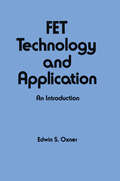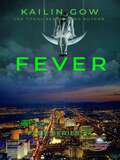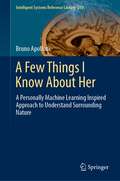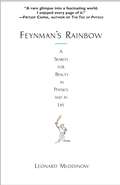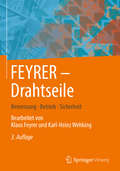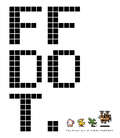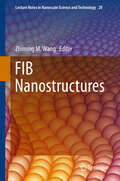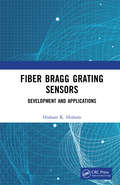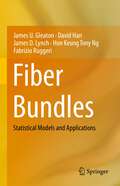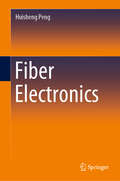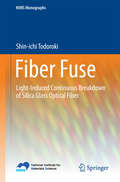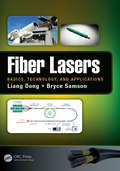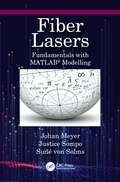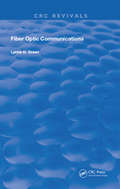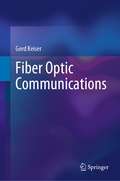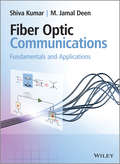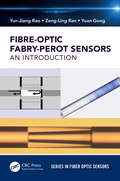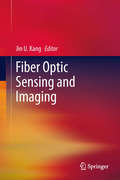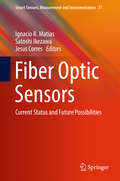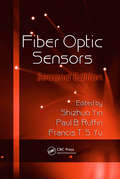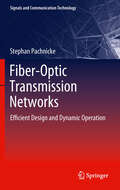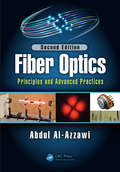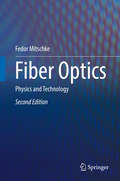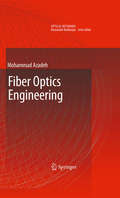- Table View
- List View
Fet Technology and Application
by E. S. OxnerThis book provides the reader with some insights into the many styles of field effect transistors (FETs) being used. It offers a rudimentary understanding of their operation and performance. The book explains the complex terminology that defines the various FET parameters.
Fever (FADE Series #4)
by Kailin GowWinner of the IBPA Benjamin Franklin Silver Award! YA (Young Adult) - appropriate for age 16 and up. Contains non-stop action, kissing, and twists that will keep you guessing to the very end. PRAISE FOR THE FADE SERIES 5 out of 5 Stars - Kailin Gow has this talent to make the readers finish the book in a day, without a break.- Kitame 5 out of 5 Star - Lots of fresh original ideas in this book that kept me guessing. If you're looking for something different in an exciting way, get Fade. - Between the Covers "If you love the girls in Amanda Hocking's and Suzanne Collins' novels, it's time you discovered bestselling YA series author Kailin Gow!" - Steve Windwalker, #1 Amazon bestselling author and Kindle Nation Magazine founder. "It's like Nikita meets Fringe! Love it!" - On My Shelf DESCRIPTION Who had survived the Apocalypse? In Fever, the fourth book and final installment in Kailin Gow's FADE dystopian thriller series, Celes' memories return with a vengeance. Jack's memories are aligned with hers, and together they embark on fulfilling the mission they had set themselves to accomplished in their past. THE FADE SERIES BOOKS FADE Falling Forgotten Fever Series Complete!
A Few Things I Know About Her: A Personally Machine Learning Inspired Approach to Understand Surrounding Nature (Intelligent Systems Reference Library #219)
by Bruno ApolloniThis book reconsiders key issues, such as description and explanation, which affect data analytics. For starters: the soul does not exist. Once released from this cumbersome roommate, we are left with complex biological systems: namely, ourselves, who must configure their environment in terms of worlds that are compatible with what they sense. Far from supplying yet another cosmogony, the book provides the cultivated reader with computational tools for describing and understanding data arising from his surroundings, such as climate parameters or stock market trends, even the win/defeat story of his son football team. Besides the superposition of the very many universes considered by quantum mechanics, we aim to manage families of worlds that may have generated those data through the key feature of their compatibility. Starting from a sharp engineering of ourselves in term of pairs consisting of genome plus a neuron ensemble, we toss this feature in different cognitive frameworks within a span of exploitations ranging from probability distributions to the latest implementations of machine learning. From the perspective of human society as an ensemble of the above pairs, the book also provides scientific tools for analyzing the benefits and drawbacks of the modern paradigm of the world as a service.
Feynman's Rainbow: A Search for Beauty in Physics and in Life
by Leonard MlodinowAcademic scientist turned Hollywood screen writer, Mlodinow recounts his first year on the faculty at California Technical Institute, beginning in winter 1981, and his interactions there with renowned physicist Richard Feynman during his last years. Annotation (c)2003 Book News, Inc., Portland, OR (booknews.com)
FEYRER: Bemessung, Betrieb, Sicherheit
by Klaus Feyrer Karl-Heinz WehkingIn den vergangenen Jahren haben die Ergebnisse zahlreicher Forschungsarbeiten zu weiteren Verbesserungen und einer umfangreichen Bearbeitung des Buches geführt.Die Darstellung der Methoden zur Berechnung wichtiger Seilgrößen und ihre Erläuterung durch Rechenbeispiele sind ein besonderes Anliegen dieser Neuauflage. Die Anzahl der Rechenbeispiele wurden, zur besseren Veranschaulichung, erhöht. Darüber hinaus gibt es eine Reihe von Excel-gestützten Rechenprogrammen, die kostenlos abgerufen werden können. Die Dimensionierungs- und Berechnungsmöglichkeiten rund um das Drahtseil werden damit wesentlich vereinfacht und verbessert.
FF DOT: The Pixel Art of Final Fantasy
by Square EnixA hardcover volume that showcases the intriguing evolution of pixel art from the Final Fantasy series!Containing detailed sprite sheets that showcase the pixel composition of Final Fantasy's beloved characters, maps of Final Fantasy's most popular highlighting tools used by the developers, and a special interview with Kazuko Shibuya, the character pixel artist for the Final Fantasy series, FF Dot is a one of a kind product that immerses readers into an iconic aspect of the Final Fantasy experience. Dark Horse Books is proud to collaborate with Square Enix to bring fans FF Dot: The Pixel Art of Final Fantasy, translated into English for the first time. This localization of the original Japanese publication holds nearly 300 pages of colorful pixel art, and is an invaluable addition to any Final Fantasy fan's collection.
FIB Nanostructures
by Zhiming M. WangFIB Nanostructures reviews a range of methods, including milling, etching, deposition, and implantation, applied to manipulate structures at the nanoscale. Focused Ion Beam (FIB) is an important tool for manipulating the structure of materials at the nanoscale, and substantially extends the range of possible applications of nanofabrication. FIB techniques are widely used in the semiconductor industry and in materials research for deposition and ablation, including the fabrication of nanostructures such as nanowires, nanotubes, nanoneedles, graphene sheets, quantum dots, etc. The main objective of this book is to create a platform for knowledge sharing and dissemination of the latest advances in novel areas of FIB for nanostructures and related materials and devices, and to provide a comprehensive introduction to the field and directions for further research. Chapters written by leading scientists throughout the world create a fundamental bridge between focused ion beam and nanotechnology that is intended to stimulate readers' interest in developing new types of nanostructures for application to semiconductor technology. These applications are increasingly important for the future development of materials science, energy technology, and electronic devices. The book can be recommended for physics, electrical engineering, and materials science departments as a reference on materials science and device design.
Fiber Bragg Grating Sensors: Development and Applications
by Hisham K. HishamThis book presents the basic principles of optical sensor technology in line with the tremendous development in the concept of optical fibers. In the first four chapters, the book discusses the basic principles of optical sensor technology in a simplified manner, making it suitable for all levels of study and research. The seven remaining chapters are concerned with the practical applications of optical sensor technology in all fields such as oil and gas, civil engineering, medical and military fields and harsh environments.
Fiber Bundles: Statistical Models and Applications
by James U. Gleaton David Han James D. Lynch Hon Keung Ng Fabrizio RuggeriThis book presents a critical overview of statistical fiber bundle models, including existing models and potential new ones. The authors focus on both the physical and statistical aspects of a specific load-sharing example: the breakdown for circuits of capacitors and related dielectrics. In addition, they investigate some areas of open research.This book is designed for graduate students and researchers in statistics, materials science, engineering, physics, and related fields, as well as practitioners and technicians in materials science and mechanical engineering.
Fiber Electronics
by Huisheng PengThis book highlights the main advances in fiber electronics, like fiber-shaped solar cells, batteries, supercapacitors, sensors, light-emitting devices, memristors and communication devices from the standpoints of material synthesis, structure design and property enhancement. It focuses on revealing the separation and transport mechanisms of charges, establishing transport equations for electrons and ions, and emphasizing integration methods in fiber devices. In closing, it reviews emerging applications based on fiber devices that could accelerate their large-scale production in the near future. Given its scope, the book offers a valuable resource for scientists, engineers, graduate students and undergraduate students in a wide variety of fields such as advanced materials, energy, electrochemistry, applied physics, nanoscience and nanotechnology, polymer science and engineering and biomedical science. It also benefits many non-specialist industrialists who are working to promote new technologies.
Fiber Fuse
by Shin-Ichi TodorokiThis book describes the fiber fuse phenomenon that causes a serious problem for the present optical communication systems. High-power light often brings about catastrophic damage to optical devices. Silica glass optical fibers with ultralow transmission loss are not the exception. A fiber fuse appears in a heated region of the fiber cable delivering a few watts of light and runs toward the light source destroying its core region. Understanding this phenomenon is a necessary first step in the development of future optical communication systems. This book provides supplementary videos and photographs to help understand what occurs in the fiber, including the classification of its propagation mode and self-pumping effect. These findings are good references for other optical devices exposed to ultrahigh-power light such as laser emitters.
Fiber Lasers: Basics, Technology, and Applications
by Liang Dong Bryce SamsonThe fiber laser, with its humble beginning in the late 1980s, has undergone tremendous development in the past decade or so, transforming itself from a research curiosity to a major force in modern manufacturing. Today, it is revolutionizing our economy by fundamentally changing the way we mark, machine, and process materials on an industrial scale. The recent development of high-power fiber lasers is also fundamentally shaping a wide range of other areas from physical sciences and medicine to geology and space exploration. In the past few years, the tactical deployment of direct energy weapons based on fiber lasers has become a reality. The development of fiber lasers is rooted in a number of technical areas including optical materials, optical waveguide design, nonlinear optics, optical fiber fabrication, and optical characterization, in addition to optical fiber components, and fiber laser design and architecture. No comprehensive in-depth coverage of such diverse topical areas has appeared in a single book. Many important developments have taken place in the past decade in both academia and industry. This book comprehensively covers the basics, technology and applications of fiber lasers including up-to-date developments in both academia and industry and is aimed to serve as both an introduction and research aid for graduate students, engineers, and scientists who are new to this field and also for veterans in the field
Fiber Lasers: Fundamentals with MATLAB® Modelling
by Johan Meyer Suné Von Solms Justice SompoOver the past two decades, the use of fiber lasers in engineering applications has gradually become established as an engineering discipline on its own. The development of fiber lasers is mainly the result of studies from various domains like photonics, optical sensing, fiber optics, nonlinear optics, and telecommunication. Though many excellent books exist on each of these subjects, and several have been written specifically to address lasers and fiber lasers, it is still difficult to find one book where the diverse core of subjects that are central to the study of fiber laser systems are presented in simple and straight forward way. Fiber Lasers: Fundamentals with MATLAB Modelling, is an introduction to the fundamentals of fiber lasers. It provides clear explanations of physical concepts supporting the field of fiber lasers. Fiber lasers’ characteristics are analyzed theoretically through simulations derived from numerical models. The authors cover fundamental principles involved in the generation of laser light through both continuous-wave (CW) and pulsing. It also covers experimental configuration and characterization for both CW and Q-switching. The authors describe the simulation of fiber laser systems and propose numerical modelling of various fiber laser schemes. MATLAB® modelling and numerical computational methods are used throughout the book to simulate different fiber laser system configurations. This book will be highly desirable and beneficial for both academics and industry professionals to have ample examples of fiber laser approaches that are well thought out and fully integrated with the subjects covered in the text. This book is written to address these needs.
Fiber Optic Communications (Routledge Revivals)
by Lynne D. GreenFirst published in 1993: This book is an outgrowth of fiber optic design courses given by the author.
Fiber Optic Communications
by Gerd KeiserThis book highlights the fundamental principles of optical fiber technology required for understanding modern high-capacity lightwave telecom networks. Such networks have become an indispensable part of society with applications ranging from simple web browsing to critical healthcare diagnosis and cloud computing. Since users expect these services to always be available, careful engineering is required in all technologies ranging from component development to network operations. To achieve this understanding, this book first presents a comprehensive treatment of various optical fiber structures and diverse photonic components used in optical fiber networks. Following this discussion are the fundamental design principles of digital and analog optical fiber transmission links. The concluding chapters present the architectures and performance characteristics of optical networks.
Fiber Optic Communications
by Shiva Kumar M. Jamal DeenFiber-optic communication systems have advanced dramatically over the last four decades, since the era of copper cables, resulting in low-cost and high-bandwidth transmission. Fiber optics is now the backbone of the internet and long-distance telecommunication. Without it we would not enjoy the benefits of high-speed internet, or low-rate international telephone calls.This book introduces the basic concepts of fiber-optic communication in a pedagogical way. The important mathematical results are derived by first principles rather than citing research articles. In addition, physical interpretations and real-world analogies are provided to help students grasp the fundamental concepts.Key Features: Lucid explanation of key topics such as fibers, lasers, and photodetectors.Includes recent developments such as coherent communication and digital signal processing.Comprehensive treatment of fiber nonlinear transmission.Worked examples, exercises, and answers.Accompanying website with PowerPoint slides and numerical experiments in MATLAB.Intended primarily for senior undergraduates and graduates studying fiber-optic communications, the book is also suitable as a professional resource for researchers working in the field of fiber-optic communications.
Fiber-Optic Fabry-Perot Sensors: An Introduction (Series in Fiber Optic Sensors)
by Yun-Jiang Rao Zeng-Ling Ran Yuan GongThe authors deliver a complete overview of fiber-optic Fabry-Perot (FFP) sensing technology, integrating the knowledge and tools of multiple fields including optics, sensing, micromachining, instrumentation, physics, and materials science. The main chapters discuss operating principles, microstructures, fabrication methods, signal demodulation, and instrumentation. This treatment spans the full range of structures (intrinsic/extrinsic, multimode fiber vs single-mode fibers), as well as advanced micromachining technologies and major interrogating and multiplexing methods for the formation of multi-point, quasi-distributed sensing networks. Readers will also gain a summary of state-of-the-art applications in oil, gas, and electricity industries, aerospace technology, and biomedicine. Yun-Jiang Rao is Dean of the School of Communication & Information Engineering, and Director of the Key Lab of Optical Fiber Sensing & Communications at the University of Electronic Science and Technology of China. Zeng-Ling Ran and Yuan Gong are both associate professors at the Optical Fiber Technology Research Laboratory of the University of Electronic Science and Technology of China.
Fiber Optic Sensing and Imaging
by Jin U. KangThis book is designed to highlight the basic principles of fiber optic imaging and sensing devices. The book provides the readers with a solid foundation in fiber optic imaging and sensing devices. The text begins with an introductory chapter that starts from Maxwell's equations and ends with the derivation of the basic optical fiber characteristic equations and solutions (i.e. fiber modes). Also covered within are reviews of the most common fiber optic interferometric devices which are the basis for many fiber optic imaging and sensing systems. The author discusses the basics of fiber optic imagers with an emphasis on fiber optic confocal microscope. Including chapters on fiber Bragg grating based sensor and various applications and fiber Sagnac loop based sensors. The book also provides useful forms of device characteristic equations.
Fiber Optic Sensors
by Ignacio R. Matias Satoshi Ikezawa Jesus CorresThis book describes important recent developments in fiber optic sensor technology and examines established and emerging applications in a broad range of fields and markets, including power engineering, chemical engineering, bioengineering, biomedical engineering, and environmental monitoring. Particular attention is devoted to niche applications where fiber optic sensors are or soon will be able to compete with conventional approaches. Beyond novel methods for the sensing of traditional parameters such as strain, temperature, and pressure, a variety of new ideas and concepts are proposed and explored. The significance of the advent of extended infrared sensors is discussed, and individual chapters focus on sensing at THz frequencies and optical sensing based on photonic crystal structures. Another important topic is the resonances generated when using thin films in conjunction with optical fibers, and the enormous potential of sensors based on lossy mode resonances, surface plasmon resonances, and long-range surface exciton polaritons. Detailed attention is also paid to fiber Bragg grating sensors and multimode interference sensors. Each chapter is written by an acknowledged expert in the subject under discussion.
Fiber Optic Sensors (Optical Science and Engineering)
by Shizhuo Yin Paul B. Ruffin Francis T. S. YuThe need for both intrinsic and extrinsic fiber optic sensor technologies continues to grow. To meet the demands of this fast expanding applications-driven market, Fiber Optic Sensors, Second Edition presents both the latest advances in fiber optic sensor technology, such as the application of photonic crystal fibers to fiber optic gyroscopes, and recent application opportunities, including the use of fiber optic sensors as a minimally invasive medical treatment. The new edition of this seminal work highlights the development of fiber optic sensors, while providing an overview of current methods for the construction of high-speed and high-capacity fiber optic systems. Two new chapters cover topics such as femtosecond laser illumination inscription and the growing application sector of fiber optic chemical and biological sensors. Adding significant new material, the book continues to provide a progressive history of each sensor type as well as basic principles and fundamental building blocks for practical applications in the electrical aerospace, defense and manufacturing, smart structure, undersea surveillance, medical, and gas and oil industries.
Fiber-Optic Transmission Networks
by Stephan PachnickeNext generation optical communication systems will have to transport a significantly increased data volume at a reduced cost per transmitted bit. To achieve these ambitious goals optimum design is crucial in combination with dynamic adaptation to actual traffic demands and improved energy efficiency. In the first part of the book the author elaborates on the design of optical transmission systems. Several methods for efficient numerical simulation are presented ranging from meta-model based optimization to parallelization techniques for solving the nonlinear Schrödinger equation. Furthermore, fast analytical and semi-analytical models are described to estimate the various degradation effects occurring on the transmission line. In the second part of the book operational aspects of optical networks are investigated. Physical layer impairment-aware routing and regenerator placement are studied. Finally, it is analyzed how the energy efficiency of a multi-layer optical core network can be increased by dynamic adaptation to traffic patterns changing in the course of the day.
Fiber Optical Parametric Amplifiers, Oscillators and Related Devices
by Michel E. MarhicThis book, published in 2007, provides comprehensive coverage of the theory and practice of OPAs and related devices, including fiber optical parametric oscillators (OPOs). After introducing the field, the theory and techniques behind all types of fiber OPAs are covered starting from first principles - topics include the scalar and vector OPA theory; the nonlinear Schrodinger equation; OPO theory; and quantum noise figure of fiber OPAs. Challenges of making fiber OPAs practical for a number of applications are discussed, and a survey of the state-of-the-art in feasibility demonstrations and performance evaluations is provided. The capabilities and limitations of OPAs; the potential applications for OPAs and OPOs, and prospects for future developments in the field are discussed. Theoretical tools developed in this text can also be applied to other areas of nonlinear optics. This is a valuable resource for researchers, advanced practitioners, and graduate students in optoelectronics.
Fiber Optics: Principles and Advanced Practices, Second Edition
by Abdul Al-AzzawiThis book provides a step-by-step discussion through each topic of fiber optics. Each chapter explores theoretical concepts of principles and then applies them by using experimental cases with numerous illustrations. The book works systematically through fiber optic cables, advanced fiber optic cables, light attenuation in optical components, fiber optic cable types and installations, fiber optic connectors, passive fiber optic devices, wavelength division multiplexing, optical amplifiers, optical receivers, opto-mechanical switches, and optical fiber communications. It includes important chapters in fiber optic lighting, fiber optics testing, and laboratory safety.
Fiber Optics
by Fedor MitschkeTelephone, telefax, email and internet - the key ingredient of the inner workings is the conduit: the line which is designed to carry massive amounts of data at breakneck speed. In their data-carrying capacity optical fiber lines beat other technologies (copper cable, microwave beacons, satellite links) hands down, at least in the long haul. This book is a comprehensive source about optical fibers: Their structure, their light-guiding mechanism, their material and manufacture, their use. Several effects tend to degrade the signal as it travels down the fiber: they are spelled out in detail. Nonlinear processes are given due consideration for a twofold reason: On one hand they are fundamentally different from the more familiar processes in electrical cable. On the other hand, they form the basis of particularly interesting and innovative applications, provided they are understood well enough. A case in point is the use of so-called solitons, i.e. special pulses of light which have the wonderful property of being able to heal after perturbation. The book starts with the physical basics of ray and beam optics, explains fiber structure and the functions of optical elements, and continues to the forefront of applications. The state of the art of high speed data transmission will be described, and the use of fiber optic sensors in metrology is treated. The book is written in a pedagogical style so that students of both physics and electrical engineering, as well as technicians and engineers involved in optical technologies, will benefit.
Fiber Optics Engineering
by Mohammad AzadehThe book covers the area of fiber optics from an engineering perspective. Emphasis is placed on data conversion between electrical and optical domains and the way limitations in each domain affect the other domain. Techniques to improve the fidelity of this conversion (both from electrical to optical domain, and vise versa) are also covered. The first few chapters cover the required theoretical background including fundamentals of fiber optics communication, fiber optics networks, converting the electrical data to light, light transmission in the medium of fiber as well as converting light back to electrical signal. A critical chapter is dedicated to characterization of optical signals. The following chapters use the theoretical background to address the design of fiber optic transceivers. The author emphasizes issues that fiber optic engineers should be familiar with, but are rarely discussed in books because they belong to an area which is neither purely electrical nor optical. The last few chapters cover issues such as standards (ITU, IEEE, FSAN, etc.), test and measurement methodologies, and reliability (over temperature performance, aging, failure rates, shock and vibration, etc.).
